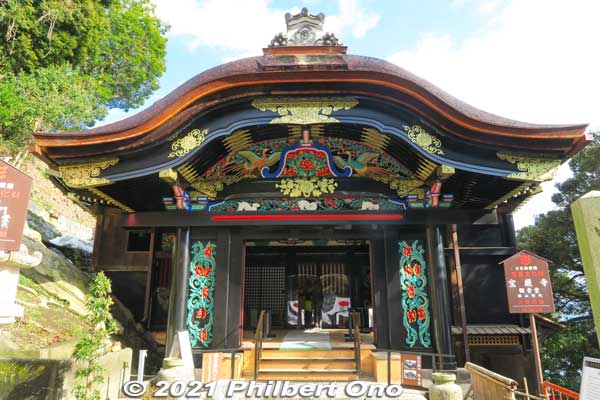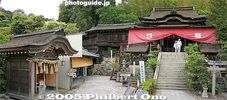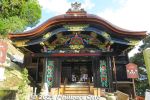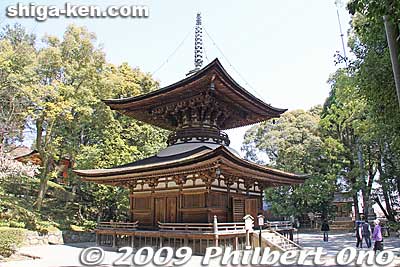National Treasures of Shiga Prefecture: Difference between revisions
No edit summary |
No edit summary |
||
| (2 intermediate revisions by the same user not shown) | |||
| Line 2: | Line 2: | ||
<table width="402" border="1" rules=all bordercolor="#9999cc" cellspacing="0" cellpadding="2" align="right"> | <table width="402" border="1" rules=all bordercolor="#9999cc" cellspacing="0" cellpadding="2" align="right"> | ||
<tr> | <tr> | ||
<td align="right" valign="middle"><div align="center"><a href="https://photoguide.jp/pix/thumbnails.php?album= | <td align="right" valign="middle"><div align="center"><a href="https://photoguide.jp/pix/thumbnails.php?album=18" target="window"><img src="https://photoguide.jp/pix/albums/shiga/nagahama/chikubushima/ch457-20210131_5722a.jpg" alt="chikubushima karamon" width="400" align="middle"></a></div></td> | ||
</tr> | </tr> | ||
<tr> | <tr> | ||
<td align="left" valign="top" style="font-size: 90%;"> | <td align="left" valign="top" style="font-size: 90%;">Karamon Gate, Chikubushima.</td> | ||
</tr> | </tr> | ||
</table> | </table> | ||
</HTML> | </HTML> | ||
by [[Philbert Ono]], ''Updated: | by [[Philbert Ono]], ''Updated: Jan. 11, 2022'' | ||
Japan's Ministry of Education, Culture, Sports, Science and Technology has The Agency for Cultural Affairs (''Bunka-cho'' 文化庁) that designates tangible and intangible things, places, and people having important cultural or historical value with official designations such as '''Important Cultural Property''' (''Juyo Bunka-zai'' 重要文化財) and '''National Treasure''' (''Kokuho'' 国宝). '''Important Intangible Cultural Property''' (''Juyo Mukei Bunka-zai'' 重要無形文化財) is a non-physical thing such as a performance or artistic technique designated as outstanding. People with exceptional talent in performing arts (演劇) such as kabuki and Noh, in music (音楽), or in fine arts (工芸技術) such as pottery and painting can be designated as a '''Living National Treasure''' (''Ningen Kokuho'' 人間国宝). | Japan's Ministry of Education, Culture, Sports, Science and Technology has The Agency for Cultural Affairs (''Bunka-cho'' 文化庁) that designates tangible and intangible things, places, and people having important cultural or historical value with official designations such as '''Important Cultural Property''' (''Juyo Bunka-zai'' 重要文化財) and '''National Treasure''' (''Kokuho'' 国宝). '''Important Intangible Cultural Property''' (''Juyo Mukei Bunka-zai'' 重要無形文化財) is a non-physical thing such as a performance or artistic technique designated as outstanding. People with exceptional talent in performing arts (演劇) such as kabuki and Noh, in music (音楽), or in fine arts (工芸技術) such as pottery and painting can be designated as a '''Living National Treasure''' (''Ningen Kokuho'' 人間国宝). | ||
| Line 15: | Line 15: | ||
The owners of Important Cultural Properties or National Treasures, Living National Treasures, and practitioners (including organizations and groups) of important intangible cultural arts receive a subsidy from the Japanese government to maintain or repair the cultural property or to practice the art. Living National Treasures receive ¥2 million annually. | The owners of Important Cultural Properties or National Treasures, Living National Treasures, and practitioners (including organizations and groups) of important intangible cultural arts receive a subsidy from the Japanese government to maintain or repair the cultural property or to practice the art. Living National Treasures receive ¥2 million annually. | ||
As of March | As of March 1, 2020, Shiga Prefecture has 22 buildings designated as National Treasures. This is the third highest number in Japan after Nara (64) and Kyoto Prefectures (51). They are mostly Buddhist temple and Shinto shrine buildings. (Thumbnails of most them below.) In total, there are 227 buildings in Japan designated as National Treasures. There are many more buildings in designated as an Important Cultural Property. | ||
<HTML> | <HTML> | ||
| Line 47: | Line 45: | ||
<tr> | <tr> | ||
<td><span class="plainlinks"><a href="https://photoguide.jp/pix/thumbnails.php?album=18" class="external text" title="https://photoguide.jp/pix/thumbnails.php?album=18" rel="nofollow"><img src="https://photoguide.jp/pix/albums/shiga/chikubushima/thumb_ci477-IMG_1414.jpg" alt="thumb_IMG_1414.jpg" /></a></span> | <td><span class="plainlinks"><a href="https://photoguide.jp/pix/thumbnails.php?album=18" class="external text" title="https://photoguide.jp/pix/thumbnails.php?album=18" rel="nofollow"><img src="https://photoguide.jp/pix/albums/shiga/chikubushima/thumb_ci477-IMG_1414.jpg" alt="thumb_IMG_1414.jpg" /></a></span> | ||
</td><td><span class="plainlinks"><a href="https://photoguide.jp/pix/thumbnails.php?album=18" class="external text" title="https://photoguide.jp/pix/thumbnails.php?album=18" rel="nofollow"><img src="https://photoguide.jp/pix/albums/shiga/chikubushima/ | </td><td><span class="plainlinks"><a href="https://photoguide.jp/pix/thumbnails.php?album=18" class="external text" title="https://photoguide.jp/pix/thumbnails.php?album=18" rel="nofollow"><img src="https://photoguide.jp/pix/albums/shiga/nagahama/chikubushima/thumb_ch457-20210131_5722a.jpg" alt="thumb_IMG_1486.jpg" /></a></span> | ||
</td><td><span class="plainlinks"><a href="https://photoguide.jp/pix/thumbnails.php?album=683" class="external text" title="https://photoguide.jp/pix/thumbnails.php?album=683" rel="nofollow"><img src="https://photoguide.jp/pix/albums/shiga/yasu/mikamishrine/thumb_mi020-20080525_4439.jpg" alt="thumb_mi020-20080525_4439.jpg" /></a></span> | </td><td><span class="plainlinks"><a href="https://photoguide.jp/pix/thumbnails.php?album=683" class="external text" title="https://photoguide.jp/pix/thumbnails.php?album=683" rel="nofollow"><img src="https://photoguide.jp/pix/albums/shiga/yasu/mikamishrine/thumb_mi020-20080525_4439.jpg" alt="thumb_mi020-20080525_4439.jpg" /></a></span> | ||
</td><td><span class="plainlinks"><a href="https://photoguide.jp/pix/thumbnails.php?album=653" class="external text" title="https://photoguide.jp/pix/thumbnails.php?album=653" rel="nofollow"><img src="https://photoguide.jp/pix/albums/shiga/yasu/osasahara/thumb_sa109-20091010_4949.jpg" alt="thumb_sa109-20091010_4949.jpg" /></a></span> | </td><td><span class="plainlinks"><a href="https://photoguide.jp/pix/thumbnails.php?album=653" class="external text" title="https://photoguide.jp/pix/thumbnails.php?album=653" rel="nofollow"><img src="https://photoguide.jp/pix/albums/shiga/yasu/osasahara/thumb_sa109-20091010_4949.jpg" alt="thumb_sa109-20091010_4949.jpg" /></a></span> | ||
| Line 130: | Line 128: | ||
*[https://photoguide.jp/pix/thumbnails.php?album=16 '''Zensuiji Hondo Hall'''] 善水寺本堂, [[Konan, Shiga]] [http://goo.gl/maps/94gbC Map] - Established in the 8th century and one of the Konan Sanzan Trio of Tendai Buddhist National Treasure temples in Konan. The Hondo Hall is large and very elegant looking. Very similar to Kongorinji temple. | *[https://photoguide.jp/pix/thumbnails.php?album=16 '''Zensuiji Hondo Hall'''] 善水寺本堂, [[Konan, Shiga]] [http://goo.gl/maps/94gbC Map] - Established in the 8th century and one of the Konan Sanzan Trio of Tendai Buddhist National Treasure temples in Konan. The Hondo Hall is large and very elegant looking. Very similar to Kongorinji temple. | ||
*[https://photoguide.jp/pix/thumbnails.php?album=173 '''Chojuji Hondo Hall'''] 長寿寺 長寿寺本堂, [[Konan, Shiga]] [http://goo.gl/maps/QVZMv Map] - Meaning "Long Life Temple," Chojuji belongs to the Tendai Buddhist Sect and is one of the Konan Sanzan Temple Trio. The Hondo Hall is small, but beautiful. Rebuilt during the Kamakura Period after a fire. | *[https://photoguide.jp/pix/thumbnails.php?album=173 '''Chojuji Hondo Hall'''] 長寿寺 長寿寺本堂, [[Konan, Shiga]] [http://goo.gl/maps/QVZMv Map] - Meaning "Long Life Temple," Chojuji belongs to the Tendai Buddhist Sect and is one of the Konan Sanzan Temple Trio. The Hondo Hall is small, but beautiful. Rebuilt during the Kamakura Period after a fire. | ||
*[https://photoguide.jp/pix/thumbnails.php?album=18 '''Karamon Gate, Hogonji Temple'''] 宝厳寺唐門, Chikubushima, [[Nagahama, Shiga]] [http://goo.gl/maps/UasqW Map] - Entrance to | *[https://photoguide.jp/pix/thumbnails.php?album=18 '''Karamon Gate, Hogonji Temple'''] 宝厳寺唐門, Chikubushima, [[Nagahama, Shiga]] [http://goo.gl/maps/UasqW Map] - Entrance to Hogonji Temple's Kannondo Hall with a karahafu-style roof. Said to have come from Toyotomi Hideyoshi's original mausoleum in Kyoto from the Momoyama Period. It was also the gate to the Gokuraku Bridge at Hideyoshi's Osaka Castle in the early 17th century. After six years in March 2020, Karamon Gate and Kannon-do Hall were beautifully restored to their original splendor with wood carvings, pillars, and other fixtures in vibrant colors. | ||
<HTML> | <HTML> | ||
Latest revision as of 04:50, 11 January 2022
| Karamon Gate, Chikubushima. |
by Philbert Ono, Updated: Jan. 11, 2022
Japan's Ministry of Education, Culture, Sports, Science and Technology has The Agency for Cultural Affairs (Bunka-cho 文化庁) that designates tangible and intangible things, places, and people having important cultural or historical value with official designations such as Important Cultural Property (Juyo Bunka-zai 重要文化財) and National Treasure (Kokuho 国宝). Important Intangible Cultural Property (Juyo Mukei Bunka-zai 重要無形文化財) is a non-physical thing such as a performance or artistic technique designated as outstanding. People with exceptional talent in performing arts (演劇) such as kabuki and Noh, in music (音楽), or in fine arts (工芸技術) such as pottery and painting can be designated as a Living National Treasure (Ningen Kokuho 人間国宝).
The owners of Important Cultural Properties or National Treasures, Living National Treasures, and practitioners (including organizations and groups) of important intangible cultural arts receive a subsidy from the Japanese government to maintain or repair the cultural property or to practice the art. Living National Treasures receive ¥2 million annually.
As of March 1, 2020, Shiga Prefecture has 22 buildings designated as National Treasures. This is the third highest number in Japan after Nara (64) and Kyoto Prefectures (51). They are mostly Buddhist temple and Shinto shrine buildings. (Thumbnails of most them below.) In total, there are 227 buildings in Japan designated as National Treasures. There are many more buildings in designated as an Important Cultural Property.
The following is a list of National Treasure buildings in Shiga Prefecture. Click on the links to see more photos.
| Hikone Castle |
Castles
- Hikone Castle, 彦根城天守、附櫓及び多聞櫓2棟 Hikone, Shiga Map - Hikone Castle is one of five main castle towers in Japan designated as a National Treasure. Hikone Castle's main tenshu tower is noted for using a wide variety of roof gables and other unique features. The tenshu tower largely retains the original construction. When Hikone Castle was built by the Ii Clan in the early 17th century, this main tower was transplanted from Otsu Castle in Otsu, Shiga in 1606. After climbing steep stairs, see fine views of the city and lake from the top floor. Hikone Castle also has other buildings that are Important Cultural Properties such as the horse stable.
Shinto Shrines
- Onjoji Shinrazen Shindo Hall (Miidera) 園城寺新羅善神堂, Otsu, Shiga Map - Cannot be viewed by the public.
- Mikami Jinja Shrine Honden Hall 御上神社本殿, Yasu, Shiga Map - Mikami Shrine's Honden was Shiga's first Shinto shrine building to be designated as a National Treasure. It is a mixture of Shinto shrine and Buddhist temple architecture dating from the Kamakura Period, about 700 years ago.
- Osasahara Jinja Shrine Honden Hall 大笹原神社本殿, Yasu, Shiga Map - A small structure dating from the mid-Heian Period. Dedicated to the god Susano-o.
- Tsukubusuma Shrine Honden Hall 都久夫須麻神社本殿, Chikubushima, [[[Nagahama, Shiga]] Map - One of the main buildings on Chikubushima island. Formerly part of Hogonji temple before Buddhist temples and Shinto shrines had to be separated.
- Hiyoshi Taisha Shrine Nishi Hongu Honden Hall 日吉大社西本宮本殿, Otsu, Shiga Map - Nishi Hongu Honden Hall is only one of three buildings in Japan which represent the Hie-zukuri (日吉造り) architectural style. Hiyoshi Taisha Shrine at the foot of Mt. Hie in Otsu is the head shrine for all Hiyoshi, Hie, and Sanno Shrines in Japan (around 2,000)
- Hiyoshi Taisha Shrine Higashi Hongu Honden Hall 日吉大社東本宮本殿, Otsu, Shiga Map - Higashi Hongu Honden Hall is only one of three buildings in Japan which represent the Hie-zukuri (日吉造り) architectural style. This hall worships the mountain god (Oyamakui-no-kami) of Mt. Hiei. Built in 1595.
- Namura Shrine, Nishi Honden 苗村神社 西本殿, Ryuo, Shiga Map - The shrine's architecture is from the Kamakura Period. Dedicated to a god named Kuni-no-sazuchi-no-Mikoto (国狭槌命), the protector of grassy hills.
Buddhist Temples
| Tahoto Pagoda at Ishiyama-dera temple. |
- Onjoji (Miidera) Kondo Hall 園城寺金堂, Otsu, Shiga Map - Miidera's main worship hall built in 1599. Elegant roof lines. You can enter and pray inside.
- Enryakuji Konpon Chudo Hall 延暦寺根本中堂, Otsu, Shiga Map - Enryakuji is part of a World Heritage Site. Konpon Chudo Hall is Enryakuji's main worship hall and largest building. Constructed in 1642 by Shogun Tokugawa Iemitsu. The architectural style is unique to the Tendai Sect and Mt. Hie. Enshrines the Yakushi-nyorai Buddha for medicines. The building is undergoing a major 10-year renovation until 2026.
- Kongorinji Hondo Hall 金剛輪寺本堂, Aisho, Shiga Map - Tendai Buddhist temple established in 741 and the middle temple in the Koto Sanzan Temple Trio. The Hondo Hall houses an 11-faced Kannon statue and 13 other statues designated as Important Cultural Properties.
- Jorakuji Hondo Hall 常楽寺本堂, Konan, Shiga Map - Jorakuji Temple (est. 708) of the Tendai Buddhist Sect boasts two National Treasures with its main Hondo Hall and three-story pagoda. It is one of the Konan Sanzan Temple Trio. The Hondo Hall is not that big, but aesthetically beautiful.
- Jorakuji Three-story Pagoda 常楽寺三重塔, Konan, Shiga Map - Jorakuji's Three-story pagoda was built in 1400.
- Saimyoji Hondo Hall 西明寺本堂, Kora, Shiga Map - Saimyoji is a Tendai Buddhist temple and the northern-most one in the Koto Sanzan Temple Trio. In 1571, Oda Nobunaga ordered Saimyoji to be burned down right after scorching Enryakuji on Mt. Hiei. Fortunately, the Kamakura-Period Hondo Hall and the pagoda survived. The main Hondo Hall was designated as Japan's first National Treasure. It houses statues of gods with a carving of the 12 Oriental Zodiac signs on the head.
- Saimyoji Three-story Pagoda 西明寺三重塔, Map - Saimyoji's other National Treasure is the Three-story Pagoda. At certain times such as autumn, the public is allowed to enter the pagoda to view the precious paintings on the wooden walls and pillars.
- Ishiyama-dera Hondo Hall 石山寺本堂, Otsu, Shiga Map - Founded in 749, Ishiyama-dera, belonging to the Shingon Buddhist Sect, is the 13th Temple of the Saigoku Pilgrimage. The Hondo Hall has the Room of Genji where Lady Murasaki Shikibu supposedly wrote Tale of Genji, one of Japan's most famous novels.
- Tahoto Pagoda, Ishiyama-dera 石山寺多宝塔, Otsu, Shiga Map - The Tahoto was built in 1194 upon the patronage of Minamoto Yoritomo. It is Japan's oldest Tahoto and one of the three most famous ones. A tahoto pagoda has a ground floor with a dome-shaped ceiling and a square pent roof, and the second floor is round with a square roof.
- Zensuiji Hondo Hall 善水寺本堂, Konan, Shiga Map - Established in the 8th century and one of the Konan Sanzan Trio of Tendai Buddhist National Treasure temples in Konan. The Hondo Hall is large and very elegant looking. Very similar to Kongorinji temple.
- Chojuji Hondo Hall 長寿寺 長寿寺本堂, Konan, Shiga Map - Meaning "Long Life Temple," Chojuji belongs to the Tendai Buddhist Sect and is one of the Konan Sanzan Temple Trio. The Hondo Hall is small, but beautiful. Rebuilt during the Kamakura Period after a fire.
- Karamon Gate, Hogonji Temple 宝厳寺唐門, Chikubushima, Nagahama, Shiga Map - Entrance to Hogonji Temple's Kannondo Hall with a karahafu-style roof. Said to have come from Toyotomi Hideyoshi's original mausoleum in Kyoto from the Momoyama Period. It was also the gate to the Gokuraku Bridge at Hideyoshi's Osaka Castle in the early 17th century. After six years in March 2020, Karamon Gate and Kannon-do Hall were beautifully restored to their original splendor with wood carvings, pillars, and other fixtures in vibrant colors.
| Hikone Byobu |
Residences
- Kangaku-in Kyakuden, Miidera Temple 勧学院客殿 (所有者:園城寺), Otsu, Shiga Map - School for priests at Miidera Temple. Closed to the public. We can only see the gate.
- Kojo-in Kyaden Hall, Onjoji 光浄院客殿(所有者:園城寺), Otsu, Shiga Map - Dates from 1601. Closed to the public in Miidera Temple. All you see is a wall and roof.
Byobu Folding Screen
- Hikone Byobu 彦根屏風, Hikone Castle Museum, Hikone, Shiga Map - Painted on a gold-leaf paper, the byobu shows a pleasure quarters scene in Kyoto dated to be from the Edo Period’s Kan’ei era (1624-44). The byobu’s National Treasure acclaim is due to the highly skilled and meticulous painting style and the myriad of people, fashion, and objects depicted from that era.
Related Articles
| Municipalities of Shiga Prefecture 滋賀県 | ||
| Cities & Towns: Aisho-cho | Higashi-Omi | Hikone | Hino-cho | Koka | Konan | Kora-cho | Kusatsu | Maibara | Moriyama | Nagahama | Omi-Hachiman | Otsu | Ritto | Ryuo-cho | Taga-cho | Takashima | Toyosato-cho | Yasu | ||
| 愛荘町 | 東近江市 | 彦根市 | 日野町 | 甲賀市 | 湖南市 | 甲良町 | 草津市 | 米原市 | 守山市 | 長浜市 | 近江八幡市 | 大津市 | 栗東市 | 竜王町 | 多賀町 | 高島市 | 豊郷町 | 野洲市 | ||
| Municipalities of Shiga Prefecture 滋賀県 | ||
| Cities & Towns: Aisho-cho | Higashi-Omi | Hikone | Hino-cho | Koka | Konan | Kora-cho | Kusatsu | Maibara | Moriyama | Nagahama | Omi-Hachiman | Otsu | Ritto | Ryuo-cho | Taga-cho | Takashima | Toyosato-cho | Yasu | ||
| 愛荘町 | 東近江市 | 彦根市 | 日野町 | 甲賀市 | 湖南市 | 甲良町 | 草津市 | 米原市 | 守山市 | 長浜市 | 近江八幡市 | 大津市 | 栗東市 | 竜王町 | 多賀町 | 高島市 | 豊郷町 | 野洲市 | ||






















